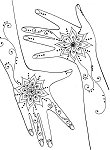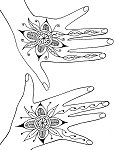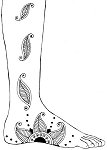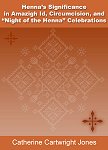alternate spelling Eid ul-Adha
also called Id Al-Kabir
The Feast of Sacrifice or The Great Feast
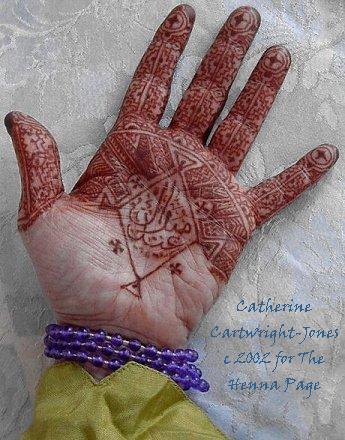
Blessed Id!
Catherine Cartwright-Jones c 2004
| Id al-Adha is
the Muslim
Feast of Sacrifice, the holiest and grandest festival of the Muslim
calendar.
Id al-Adha is the culmination of the annual pilgrimage to the
Hajj.
The Id sacrifice commemorates Ibrahim's (Abraham's) willingness to
sacrifice
his beloved son as God commanded, and demonstrate a Muslim's piety and
belief in Allah. God, in his mercy, substituted a ram at the moment of
Ibrahim's sacrifice. The Prophet Mohammed sacrificed a ram in
commemoration
of this event, and established it as a tradition for Islam. This
Islamic festival is always celebrated with henna!
Though Id al-Adha is a Muslim holiday, an annual sprintime sacrifice of animals, accompanied with henna, to secure God's blessing and expiate sins dates to at least 2200 BCE and probably as early as 7000 BCE. Artifacts and written records dating from the Bronze Age Mediterranean show that women hennaed their hands in celebration of a springtime ritual sacrifice, similar to Id, to secure fertility and blessings for the land and community. These early fertility/sacrifice festivals and their henna traditions spread into three different major religions: Judaism, Islam, and Christianity. The annual sacrifice to secure the favor of a deity was not simply symbolic. The sacrifice managed the domestic herd populations, benefiting both people and landscape. One of the keys to timing the sacrifice was henna's springtime growth surge. When the henna sprouted new shoots and leaves for the beautiful bright red henna ... it was time for sacrifice. And, for the sacrifice and celebration, the women hennaed! When Islam changed to a lunar rather than a solar calendar, Id no longer coincided with the spring equinox, but henna is still part of the celebration. The related holidays of Passover and Easter, on a solar calendar, remain near the equinox. At Id al-Adha, every Muslim head of household who can afford to do so is required to sacrifice an animal. The preferred animal is a yearling male goat, sheep, camel, bull or water buffalo. The animal has to be as perfect as possible: ungelded, with perfect teeth and horns, and beautiful markings. A ram is highly desirable as a sacrifice, and people try to purchase a ram with black rings around his eyes, as this resembles the kohled eyes of a bride. A city dwelling head of household with enough means to purchase a ram may travel to the countryside to look for a perfect creature, and bring it home with him, in his car or a taxicab. Present day urbanites keep their rams and goats in their parking garage, on the roof, or in the apartment balcony. Rural people bring the ram into their home. Both treat the animal as a member of the family, like a beloved pet and the children befriend and play with the creature. Yearling rams and goats are very companionable, generally endure cuddling and games with good grace, and are beloved playmates. Traditionally, in North Africa and Arabia, the ram or billygoat was adorned with henna at the time of sacrifice as if it were a bride, or a son for circumcision. Women hennaed the animal's hooves, tail, and forehead. They kohled the ram's eyes if they did not naturally have black rings, and darkened his lips with swak, a walnut stick. The women draped him with a bride's veil or shawl. Just before sacrifice, the ram was given a mouthful of henna. As the ram swallowed the henna, the sacrificer cut the ram's throat. (Hammoudi, 1993) This practice is less common now, under pressure for being "superstitious, old-fashioned, and un-Islamic". In Iran, prior to 1938, the ram was garlanded with flowers, beads and mirrors, and draped with a cashmere shawl. The Iranian ram was fed a taste of sugar just before sacrifice, just as an Iranian bride at her "Night of the Henna". (Masse, 1938) In Morocco, the sacrificer hennaed his hands before making the sacrificial cut. Women, children, everyone in the family got a little henna. The most common henna patterns at Id in 19th century Morocco were simple Khamsa patterns. Favorite dogs got some henna, the rest of the farm animals, even the roof pole of the house got henna. Because the festival was busy with parties, cooking, and visiting, few people had time for complex patterns. (Westermark, 1926) A third of the sacrificial meat is eaten by the sacrificer’s family during the Id holiday, a third is given to relatives, and the remaining third is given to the poor. Id al-Adha is one of the two times of the year that every Muslim, no matter how poor, can expect to eat their fill of meat. Id al-Adha is a celebration of sacrifice, religious devotion, and piety, but it is also a cheerful family holiday. It a time for presents, parties, feasts, marriages and carnivals. Cairo streets may be hung with colored lights, and paddle-tailed sheep will be staked out there for sale. Egyptian children get new clothes for Id al-Adha, and are given toy drums to play in the celebration. They often go to street fairs to ride a merry-go-round rotated by a pretty hennaed donkey. (Hoagland, 1988) Bedouin girls in Kuwait used to enjoy dancing in their tents at Id al-Adha. They removed their 'abas and burqas and danced in their brilliantly colored clothing. Older women chanted and clapped time. The girls danced, jerking stiff-legged, making their long, dark, hennaed hair fly out in a swirling, swinging motion, though they often covered their mouths with a sleeve if they thought men might see them. Male kinsmen watched them do these beautiful, sexy dances from a respectful distance. In the Kuwaiti villages, children went to street fairs set up with merry-go-rounds and swings. The "swingman" would sing loud, happy songs, and the children would sing with him. (H.R. P. Dickson, 1949) The great sharing of meat at Id al-Adha may be only one of two times in a year when poor women can eat all they wish, and have plenty of meat. This provides them with enough protein and fat to be fertile and have a successful pregnancy. The early sacrifice festivals that predated monotheism included a fertility festival, and children conceived at those festivals were considered blessed. Download a free e-book about Id and Henna Traditions! 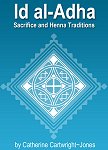 Id al-Adha: Sacrifice and Henna Traditions The Ecological and Nutritional Impact of the Muslim Feast of Sacrifice, and the Significance of Henna in this Sacrifice Catherine Cartwright-Jones TapDancing Lizard 2002
Internet references on Id al-Adha http://www.ummah.net/ramadhan/ http://www.amaana.org/arch/ismail.htm http://news.bbc.co.uk/1/hi/world/middle_east/1836039.stm http://www.islamicgarden.com/page1021.html Internet references on Id and contemporary society http://news.bbc.co.uk/2/hi/business/1835452.stm http://news.bbc.co.uk/1/hi/world/middle_east/674088.stm http://news.bbc.co.uk/2/hi/south_asia/1837703.stm http://news.bbc.co.uk/2/hi/south_asia/681128.stm http://news.bbc.co.uk/1/hi/world/middle_east/679775.stm http://news.bbc.co.uk/1/hi/world/middle_east/674088.stm http://news.bbc.co.uk/2/hi/business/1835452.stm http://news.bbc.co.uk/2/hi/uk_news/2546917.stm http://news.bbc.co.uk/2/hi/south_asia/1841502.stm Reference books: The Victim and Its Masks
Ritual and Belief in Morocco Coyances et Coutumes
Persanes,
1938 The Arab of the Desert:
Back to the Encyclopedia of Henna Index Can't find what you're
looking
for? Try: *"Henna,
the
Joyous Body Art"
the Encyclopedia of Henna Catherine Cartwright-Jones c 2000 registered with the US Library of Congress TXu 952-968 |

